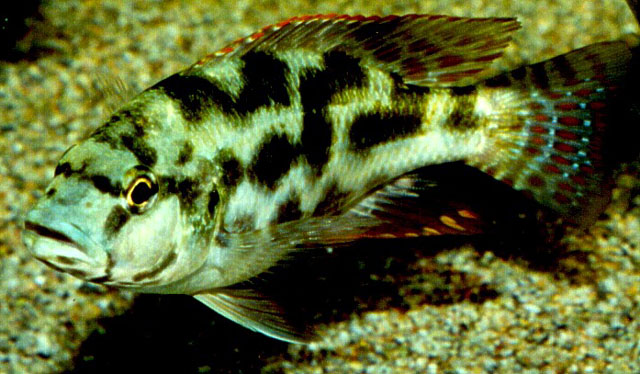| Cichlidae (Cichlids), subfamily: Pseudocrenilabrinae |
| 23 cm TL (male/unsexed) |
|
demersal; freshwater; pH range: 7.5 - 8.5; dH range: 10 - 18; depth range 0 - 76 m, non-migratory |
| Africa: endemic to Lake Malawi; widespread. |
|
Dorsal spines (total): 15-17; Dorsal soft rays (total): 9-12; Anal spines: 3-4; Anal soft rays: 9-11. Diagnosis: dark spots on pectoral fins; pattern of speckles on body and head; without conspicuous dark bars radiating from the eye; no downward-directed snout; mouth terminal; premaxillary pedicel length <34% head length (Ref. 55922).
Description: outer teeth in jaw stout and unicuspid, sometimes a few bicuspid in larger specimens, and bicuspid in small specimens; inner teeth in jaw stout and (weakly) tricuspid, slightly or strongly recurved in large specimens; 3-4 series of scales on the cheek; lower pharyngeal jaw normal or slightly broad and shallow; pharyngeal teeth widely set, sharp and stout, and occasionally enlarged; gill-rakers normal or short, the largest somewhat flattened but not polyfid; 21-25 scales in upper part of lateral line, 11-16 in lower part; 5-6 scales between pectoral and pelvic fins (Ref. 55922).
Coloration: Live: melanin pattern as in preserved fish; nuptial color pattern overlays the speckled pattern in males, and possibly also in reproductively active females (Ref. 55922). Adult territorial males: characteristic spotted pattern not readily observable; lips green-blue; dorsal, caudal and anal fins blue; dorsal fin with red-orange lappets and white submarginal band; brown maculae and striae pattern not well developed; anal fin yellow/orange distally; pelvic fins dark with white leading edge; less territorial males may have a blue head and yellow body with dark brown spots and speckles, and distal part of anal fin brown-orange (Ref. 55922). Females and immature males: background color white or yellow with many dark brown speckles and spots, to a large extend arranged in rows on dorsal, caudal and anal fin (Ref. 55922). Preserved: speckles and spots on head, body and fins, either as large speckles or giving a more peppered appearance, variable, sometimes difficult to observe; speckles on pectoral fins always present; general body color in both males and females yellow to dark brown; blotches more or less in 5 longitudinal series: 2 dorsal series, 1 midlateral series and 2 ventral series; fins dark brown in larger specimens, camouflaging the speckled pattern except in the pectoral fins; lappets of dorsal fin, trailing edge of pelvic fin and ventral margin of anal fin white; in small specimens the maculae in the caudal fin are clearly arranged in vertical bars (Ref. 55922). |
| Most common in mixed rock-sand habitats and vegetated areas (Ref. 55922). Occurs in small groups in rocky areas with beds of Vallisneria and Potamogeton (Ref. 3817). Feeds mainly on fish (Ref. 267). Hunts in pairs (Ref. 3817) or in large groups (Ref. 3817, 55922). When singly, sometimes ambushing prey by lying motionless on the substrate, but not on its side (Ref. 55922). |
|
Least Concern (LC); Date assessed: 20 June 2018 Ref. (130435)
|
| harmless |
Source and more info: www.fishbase.org. For personal, classroom, and other internal use only. Not for publication.

